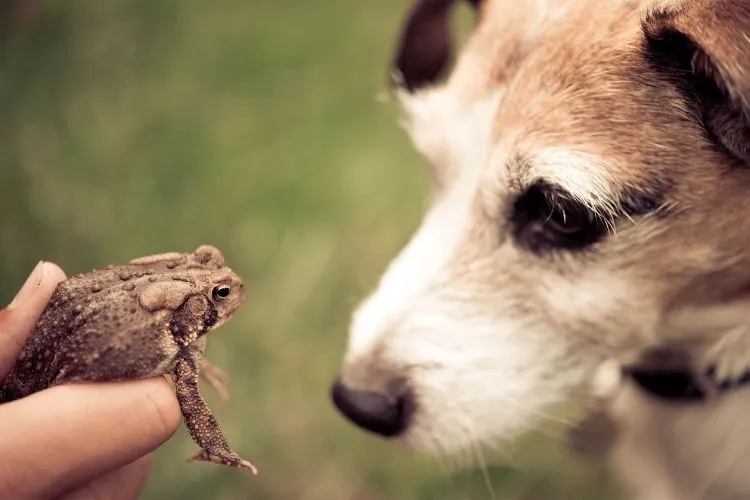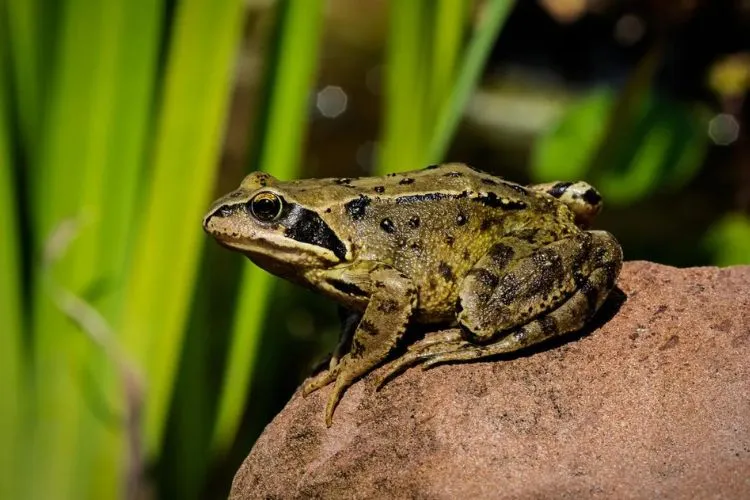As pet owners, we always worry about the safety of our furry friends, especially when it comes to the unknown risks lurking in our backyards.
One common concern is whether the frogs and toads that roam our gardens pose any danger to dogs.
So, are frogs poisonous to dogs?
This article dives into understanding the potential risks, identifying poisonous species, and providing essential safety tips to keep your pooch safe.

🐾 Are Frogs Poisonous To Dogs?
Frogs and toads, although similar in appearance, belong to different families and possess different characteristics, including their ability to secrete toxins.
Knowing which species live in your area can be crucial in assessing the risk they pose to your dog.
It’s important to differentiate between these amphibians, as toads are more commonly associated with toxic secretions harmful to dogs.
🐾 Poisonous Frogs and Toads
Several species of frogs and toads are known for their toxic secretions. For instance, the Colorado River Toad and the Cane Toad are notorious for their potent toxins which can cause severe symptoms in dogs.
When a dog comes into contact with these amphibians, toxins can quickly enter the dog’s system either through ingestion or skin contact.
Symptoms of poisoning may include excessive drooling, very red gums, vomiting, disorientation, and seizures. The severity can vary based on the amount of toxin absorbed and the size of the dog.
🐾 First Aid and Prevention
Immediate action is crucial if you suspect your dog has been poisoned by a frog or toad. Begin by rinsing your dog’s mouth out with water, making sure the water flows outward, not down the throat. Then, seek veterinary care promptly to mitigate the effects of the toxins.

To prevent such encounters, supervise your dog while outdoors, especially during the warmer months when amphibians are most active. Training your dog to come when called and to leave wildlife alone can also decrease the risk.
Additionally, keeping your garden clean and free from standing water can help deter frogs and toads from making your backyard their home.
🐾 Case Studies and Expert Opinions
Veterinarians often deal with cases of dogs being poisoned by frogs and toads, especially in regions where these toxic amphibians are common.
One case involved a young Labrador who, after a brief encounter with a Cane Toad, began to show immediate symptoms of poisoning. Thanks to the quick response of the owner, and immediate veterinary care, the dog was successfully treated and recovered.
Experts emphasize the importance of being aware of the local species in your area and educating yourself on the immediate steps to take should your dog come into contact with a poisonous frog or toad. Awareness and quick action can make a significant difference in the outcome.
🐾 Species-Specific Safety: A Closer Look at Frogs and Toads in Different Regions
The risk posed by frogs and toads to dogs varies significantly across different geographical regions, primarily due to the diverse species found around the world.
In North America, the American Toad can be a common menace in backyards, secreting a mild toxin that, while rarely fatal, can cause discomfort and drooling in dogs.
The Southwestern United States warns of the more dangerous Colorado River Toad, whose potent toxins can induce seizures and even death.

Moving to Australia, pet owners must beware of the Cane Toad. Introduced species have thrived in the tropical climate, and their toxins are powerful enough to threaten dogs that bite or lick them.
In parts of South and Central America, certain brightly colored frogs, such as those in the Dendrobatidae family (also known as dart frogs), contain powerful toxins used by indigenous people for hunting.
However, these frogs are typically less of a concern for dogs due to their rainforest habitat.
Understanding the specific species present in your locality can significantly influence the precautions necessary to protect your pet.
🐾 Handling Encounters: Practical Steps to Take If a Dog Interacts with a Frog
- Immediate Separation: Quickly and calmly separate your dog from the frog or toad to prevent further poisoning.
- Mouth Rinsing: Using a gentle stream of water, rinse the inside of your dog’s mouth, ensuring the water flows out and not down the throat. This helps to wash away toxins without causing them to be ingested.
- Observe Symptoms: Look for signs of distress such as excessive drooling, vomiting, or seizures.
- Contact Veterinarian: Regardless of symptoms, contact your veterinarian immediately for advice. Provide details about the encounter and any symptoms observed.
- Prevention: After the incident, consider ways to prevent future interactions, such as nighttime supervision or leash walks during peak amphibian activity hours.
Safety for both pet and owner is paramount; ensure you do not directly handle the amphibian, and wash your hands thoroughly after dealing with your dog.
🐾 Frequently Asked Questions (FAQs)
Not all frogs are poisonous, but it’s important to know the specific species in your area. In general, common garden frogs pose little risk, but toads, particularly the Cane Toad, are more likely to be dangerous.
Rinse your dog’s mouth with water, ensuring it flows out of the mouth, not down the throat. Avoid using a strong jet of water that could cause the toxins to be swallowed. Contact your veterinarian immediately for further advice.
Yes, dogs can get sick from merely mouthing or playing with a frog or toad, as toxins can be absorbed through the mucous membranes in the mouth.
Learning to identify local frog and toad species is crucial. Poisonous species such as the Cane Toad have distinct features such as large parotoid glands behind the eyes, which secrete toxins. When in doubt, treat all unknown amphibians as potentially harmful and prevent your dog from interacting with them.
Conclusion:
While the outdoors offers our dogs a world of excitement and exploration, it also poses certain risks like encounters with poisonous frogs and toads.
By understanding the risks, recognizing the signs of poisoning, and knowing how to respond, you can keep your dog safe.
Always supervise your pet’s outdoor time and educate yourself about the local wildlife. Remember, in cases of suspected poisoning, immediate veterinary care is essential. Keeping our furry friends safe and healthy allows them to live their happiest, most curious lives.
